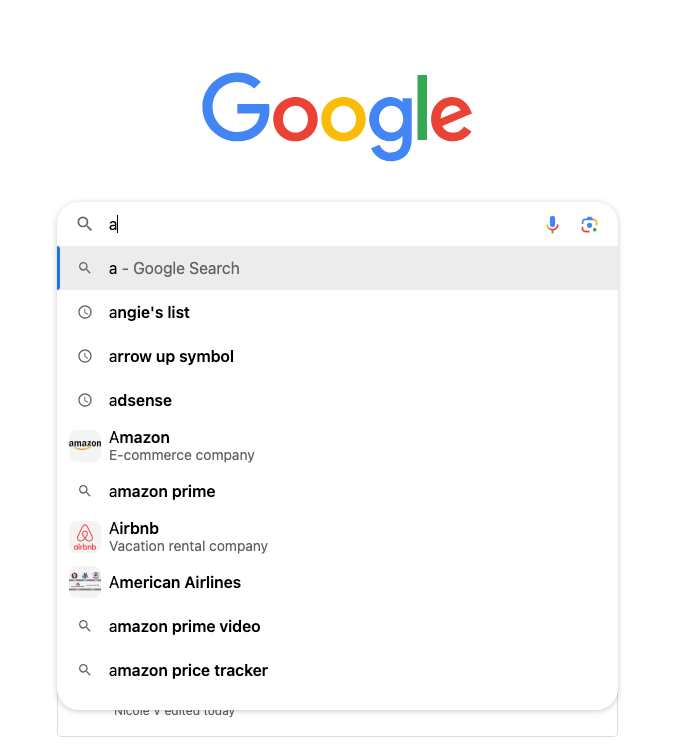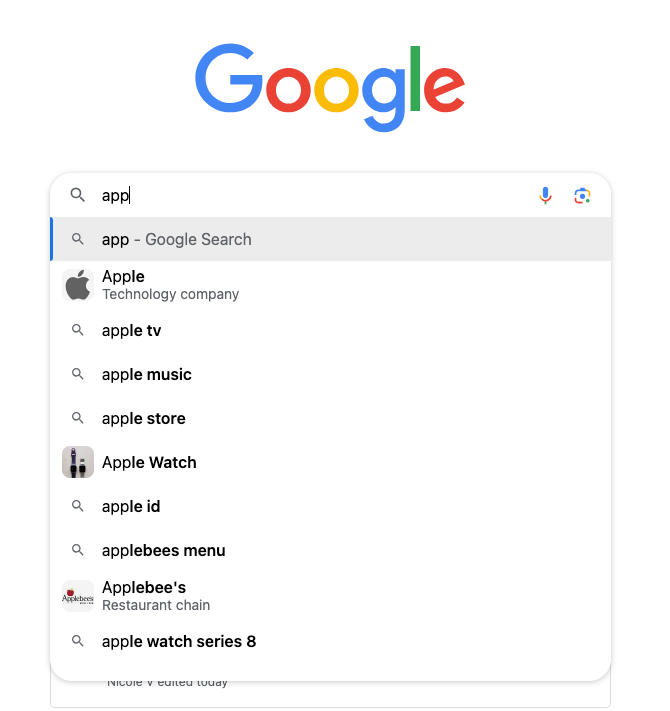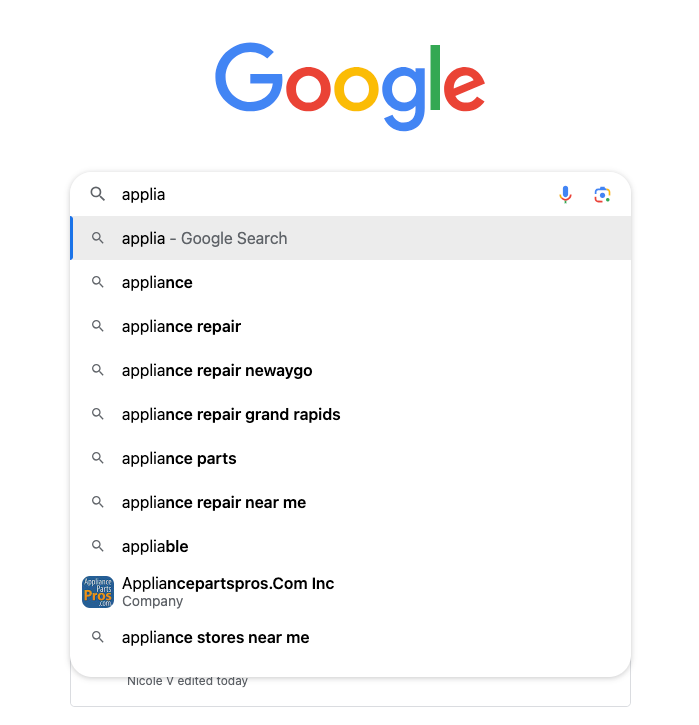
From the day search engines were released into the wild, businesses have been trying to figure out how to get to the “top of the list.”
Unlike in the ye-ole days of phone book listings, simply naming your business AAA Great Business won’t guarantee the coveted top spot. Search engines have evolved significantly since their inception. Long gone are the days when you could rank by stuffing keywords into a page.
Search engines, particularly Google, have been cracking down on spammy, keyword-stuffed pages. By conducting market research and establishing a strong foundation for your website content, you can minimize the impact of algorithm updates and prevent your website traffic from plummeting.
Now, let’s dive into Google’s content ranking criteria and explore how you can develop a content strategy with reliable and compelling content for your audience.
Understanding Google’s Ranking Factors

Google core algorithm updates pop up at least twice a year and cause ranking dips for pages with iffy content practices. Google’s number one goal is to maximize the user experience for their products.
Since Google is the leader in search engine use, it is no surprise that other search engines – Bing, Yahoo, DuckDuckGo – follow their lead when they update guidelines for ranking.
Backed by extensive market research, and years of expertise as the leading search engine, Google possesses an unparalleled understanding of user habits and desires.
Google understands the importance of user trust. If a site appears unsafe, users tend to bounce out. To maintain a top ranking, you need to prioritize trustworthy, helpful, authentic, and engaging content on your pages.
How Algorithm Updates Work
A Google algorithm update works by scanning (or crawling) all pages, then it stores information in its database which is called the index. During a search query, the engine checks for the existing and new rules that they put in place to help improve the search experience.
Then the engine displays search results, a list of pages that Google determines are the most relevant, and highest quality for the user query.
Here are a list of ranking factors that could cause a swing in your place on the search results.
- Relevance: How closely the content matches the user’s query
- Authority: Credibility and trustworthiness of the website
- User Experience: Ease of use when a user navigates and interacts with a page
- Freshness: Updated, new content
- Location: For location-specific queries, the user’s location is taken into account
The Importance of User Intent
When a user enters a query into a search engine they have a specific goal in mind. It’s the search engine’s job to give the user what they are searching for as quickly and accurately as possible. This requires Google, and other search engines, to understand various nuances and in many instances read the mind of the user.
You’ll notice this mind-reading magic when you type a search query and a list of suggested long-tailed keywords appears for you to choose from.
Let’s take a step-by-step journey into a search for “appliance stores near me” to show how Google has its SERP game set up in the user’s best interest.
Google Predictive Search Terms
Here is an example of the suggestions that populate when typing only a partial word.

I began with “a” which gave me the most searched terms that begin with “a”, also considering my search history and previous online behaviors.

Then I continue typing more characters “app” and the suggestions change based on what Google thinks I might be looking for.

As I add more to complete the word “applia” the suggestions update based on the assumed word and learning the search engine has compiled from search history, behavior, and my location.
Google’s Quality Results and SERP Features
After I chose “appliance stores near me,” the populated search term that matched what I was looking for, Google displayed the search results page with what it considered the best match for my query.
You’ll see the usual paid (sponsored) listings at the top and then the local listings for mapping out stores near me (as I specified in the search). You’ll also notice some chunks of information listing questions I might have that relate to my search query, and categories that can help me narrow my search at the top of the screen (example: discount).
All of the SERP (Search Engine Results Page) features provide valuable content for the user and help to expand upon their overall goal.
In this case, my goal is to find a store that sells discounted appliances. There is even a featured area that answers “when is the best time to buy discounted appliances” with days listed for me to easily scan.
All of this data is pulled from websites that Google has deemed most trustworthy and helpful.
Do you want to create a content strategy that puts you on the first page of search? Ask your customers what they would put in the search bar when they are looking for your products or services. Then perform a search to check who ranks for those keywords, and review which featured results come up.
You can see which content Google considers useful and trustworthy for your industry. SERP research is the catalyst for your content strategy framework.
How to Create Trustworthy Content

After reviewing how Google search engines operate, you can gain the significance of creating content that a user deems valuable.
Your content marketing efforts should focus mainly on how useful and clear your content is, as well as the credibility of the site and content creators. If your blog post is hard to read or sounds phony, then you are likely to lose the viewer as well as any gains in search engine ranking.
When you create trustworthy content, you boost the reader’s confidence in the authenticity of what they are consuming. Quality content creation focused on a specific target audience is likely to gain repeat viewers, build credibility and reputation for your company or brand, and reduce bounce rates.
Here are some tips for building trust with your audience:
Provide accurate and reliable information
It is important to ensure that the sources you use are reliable and trustworthy. Make sure to thoroughly research and verify the accuracy of your writing.
Create content with complete transparency and honesty
Little white lies and made-up content don’t fly unless you are a fiction writer. When providing advice and helpful information to your audience, make sure to cite sources and give credit where it is due.
Demonstrate expertise by providing proof
Note real-life accounts and your accreditations such as degrees, a list of studies, a list of other articles you’ve written, workshops you’ve held or taken, and work history. Anyone can say they are an expert in a subject, but Google looks for the proof to go along with your content. You can also provide proof in case studies where you show data or a project proving your success in a subject.
The Power of E-E-A-T Guidelines

Bev Mapes, Top Of The List’s leading SEO expert, mentioned Google’s E-A-T guidelines in a previous blog post, including ways to improve your site’s EAT (Expertise, Authoritativeness, Trustworthiness). As of late 2022, Google added another E for Experience. Google provides an updated 176-page PDF to explain their general guidelines for search quality ratings.
A section of the guide is dedicated to E-E-A-T, or Double E-A-T, in which they declare the most essential member as Trust.
Google values the E-E-A-T in content because it provides viewers with accurate, reliable content and combats misinformation. We break down the double E-A-T and show ways you can review and improve existing content and create a successful content strategy for E-E-A-T.
Experience (E)
The recent “Experience” addition to E-E-A-T comes at a time when digital creators are quickly and easily documenting their first-hand accounts via short videos on social media platforms like YouTube, TikTok, Insta, and Facebook Reels. They are providing proof of use and knowledge of a product or subject, but they don’t have degrees or a long history documented.
So Google began to include the validity of user experience in their ranking algorithm. Now helpful experiences that can benefit others in researching a topic are considered a valuable factor for ranking high on that subject matter. Here are some examples.
Use First Person Accounts
If you are creating a post about a product, make sure you’ve used it and tested it. Write about your first-hand “experience.” Include what you consider the pros and cons of your experience.
Outline your life experience about your subject
An example of this would be someone who is diagnosed with a disorder writing about their journey with it. They may not be a doctor or an expert educator on the subject, but they have real-life experience living through it.
In a case that does include any medical accounts, the writer should be transparent with their audience. They should also remind their audience that they are providing their experience and don’t speak for all who are living with the same disorder or illness.
Include step-by-step instructions or directions
If you create content about a process that you have experience with, include the step-by-step documentation to provide detail as well as make it easy for the reader to follow you through it. Recipe blogs often use this content strategy. They often include tips and side notes about substitutions to customize the process for specific users (e.g. removing allergens).
Expertise (E)
To be an expert, you need more than a few first-hand accounts on a topic. Expertise requires more proof and documentation to validate their status.
This especially holds true with those who create content to give advice that can affect someone’s health, wealth, or happiness. Google puts pages with this type of advice in their YMYL (Your Money, Your Life) category. Websites with YMYL content are under more scrutiny than sites that only need to be concerned with E-E-A-T guidelines.
Here are ways to provide proof of “Expertise” to help your content pass the Google credibility test for Expertise under E-E-A-T guidelines.
Establish author expertise
For every piece of advice, there needs to be a person or organization accountable for the information.
To help prove expertise, include an author for every blog post and a staff, team, or owner bio for every business or organization. Author bios need to include education and work history, a list of other publications, and any awards or memberships that they hold about the subject matter.
Cite authoritative sources
You can cite sources from other trusted websites that are known for their expertise on a topic. For example, if you have a specific point that was detailed in a scientific journal or an academic article, link the source in the footnotes or mention the source and link to the article in the body of your post.
In some cases, you should ask for permission from the original content creator before you cite or link to their work in order to avoid copyright infringement.
Provide evidence of qualifications
As a content creator, present yourself as an expert by including your qualifications in the author section at the top or bottom of the post, as well as on your detailed author biography page. List your education, work experience, list of accomplishments, and certifications in the field.
Authoritativeness (A)
Authoritative content often comes from sources that have established themselves as leaders or authorities in their respective industries or niches. These sources are more likely to have a deep understanding of their subject matter and can provide valuable insights and guidance.
Build authority in your niche
Post frequently about topics that affect your subject and invite others in the industry to weigh in. Gaining a social media following and having credible audience members sharing and interacting with your content builds authority.
Earn backlinks from reputable sources
When you write authentic and engaging content it will not only create direct organic traffic, but it is more likely to get links from sources also covering the same subject matter. Links from pages with high authority and reputable authors will also increase your site’s page and domain authority.
Highlight industry recognition and awards
Being a part of an organization or having a long-standing membership to a club in your field helps your business gain online authority. If there are competitions or awards in your industry that you can enter and place in or at least get a mention for participating in, this can also help strengthen your reputation.
Trustworthiness (T)
The capital “T” for trustworthiness, is the ultimate goal when you accumulate all other factors of E-E-A-T. Trustworthy content is transparent, honest, and reliable. Users can trust that the information presented is not biased, deceptive, or manipulative. This builds trust between the target audience and the content creator.
Use clear privacy policies and terms of service
A privacy policy and terms of service link should be in the footer of your website to ensure that it is accessible on every page. Legally, privacy policies are considered a contract and require the date of its last update.
For the most thorough and industry-appropriate policies, it is best to consult an attorney specializing in contracts. Basic privacy policies include sections outlining your cookies policy and details for what information you collect and why you collect it.
In some states and countries, it is also a requirement to have an option to “opt out” that allows users to decide what information you can collect about them.
Avoid deceptive practices
When users perceive deception in signing up for something or providing sensitive information that could jeopardize their security, the trustworthiness score of your website will drastically decline.
To present your content as trustworthy, make sure you implement a SSL security certificate on your site. You can also include a Captcha with any form to protect your customers and your site from hackers.
Another practice to avoid deception is to make clickable links obvious by styling them so they are set apart from regular text.
Showcase user testimonials and reviews
Authentic reviews and testimonials serve as proof that other users have interacted with you. Feedback on your products or services is a major form of trustworthiness.
Implement methods to show these reviews are real, rather than something that could be “made up” by anyone. For example, plugins can import reviews directly from Facebook or Google Business Profile.
Applying E-E-A-T Guidelines to Your Content Strategy

Incorporating E-E-A-T into your content strategy can significantly improve your content’s ranking and perception by Google.
There are many stages in your content marketing plan that you can reference and use E-E-A-T guidelines. It is essential to include them when you are planning to build a new website and after the website launches.
Periodic audits to improve your standing with Google are also advised since the guidelines continually change.
Here is a list of practical actions you can take to use E-E-A-T in your content strategy for a new site or while auditing your existing content for improvements:
- Complete Privacy Policy / Terms and Conditions: Ensure this content is clear and easy to find from almost anywhere on the site. Linking to them from the footer is the most common placement.
- Full Author Bios: Craft compelling author bios, with a photo of the author and their credentials.
- Add an Author List and Search: Include a list of past articles for the author, and a way to sort by author.
- Fact-check and Cite Sources: Always credit original content and make sure your sources are credible.
- Highlight Credentials and Awards: List accomplishments and memberships for your authors, staff, company, or organization. Include logos and links to community partnerships, organization memberships, or awards on the home page in the top portion to give a good first impression.
- Write a Detailed About Us Page: Include your code of ethics outlining your values and principles. Cover why you started and who is involved in the success of your organization.
- Clear Contact Info: Provide a way for a viewer to contact you if they have issues, include a local address and phone number if you are trying to reach a specific region.
- Quality Content Only: Write easy-to-read, on-topic and relevant content. Make sure it supports the main topic of the overall site. Engaging content also gets more shares on social media and Google sees that as a mark of authority.
- Freshen Up Content: Go back to old web pages and blog posts to evaluate if they need to be updated. If you repurpose content in your blog, add the original content date under the title to be transparent with viewers. They will see that you are thorough and trustworthy when you update content to keep it valid.
- Create a Content Calendar: Schedule blog posts and social media posts on a calendar and stick to a consistent rate of content production. Posting frequent content not only looks good to Google, but it can also help to generate leads from your target audience.
- Share Engaging, New Content: After you update your content or create any new, interesting content for your industry, share it on relevant Social Media Channels. A strong rate of user interaction, especially post-sharing, raises your online visibility and brand authority.
- Useful 404 Pages: Create a user-friendly 404 page on your site by adding a site search function or a link to an HTML Sitemap.
- Provide Plenty of Evidence: Include documentation and first-hand knowledge giving detailed accounts for content credibility.
- Be Personable: Show that there are humans behind the website with a staff page and individual bios for each team member, even if they aren’t an author. Nothing is worse than visiting a site and wandering around without a single name or face to put to the company.
- Include a Careers Page: Even if you aren’t hiring at the moment, include a page explaining your company culture for workers and an option to submit a resume. This shows that you employ qualified talent in your team, people that viewers want to interact with.
- Audit Your Backlinks: Use a tool like Bing WebMaster Tools or Google Search Console to check which domains and webpages are linking to your website. Are they quality websites? You can also check authority and spam scores for free on Moz, although you will need to provide your contact information.
- Don’t Link to Spammy Sites: Just like incoming links, you also don’t want low-quality outgoing links. Make sure you reference credible sources and link to websites that also follow the E-E-A-T guidelines. You can use the same tools we mentioned above to check the validity of the links.
- Include User Generated Content: Features like product reviews, comments and testimonials from customers are elements that Google considers valuable UGC (User Generated Content). When you add interactions to your content marketing strategy it helps you to increase the credibility of your website in the eyes of your users (and search engines).
- Put a Branded Copyright in the Footer: A copyright with your legal company name further legitimizes your site ownership and creates trustworthiness. Also including a high-quality company logo on every page (header and/or footer) is a great way to tie in your branding.
- Optimize for Accessibility: Build trust and credibility with a website that is easily accessible to people with disabilities. You can test your accessibility score for free on Google Page Speed Insights. Issues such as text that is too faint to read as well as links, buttons, and images that aren’t titled for screen readers, make your site less inclusive and can hurt Google rankings.
- Add a Favicon: A favicon is a small icon recognizable as part of your branding that appears on the address bar for your website pages. Favicons are easy to add to WordPress sites as well as other website builders and help to enhance brand recognition and trust.
The content improvements I listed above are just some of the steps you can take to increase your credibility with Google.
Most of these content ideas are included in comprehensive content marketing strategies created by digital marketing companies like the Top of the List. Our marketing strategists can assist you in generating credible content, as well as audit existing content and formulate a plan to improve your trustworthiness online.
Monitoring and Improving E-E-A-T

Back in the day, you could create ranking content on a website and it was easy-peasy. It didn’t take much to get your page seen in a search. You could just put up a long list of your products or services, include a business name and contact info then BINGO!, you’re a legit online business.
Online ranking has come so far from simplistic tactics and now there are billions of website pages to compete with. A set-it-and-forget-it strategy will get your pages buried in search, so include consistent monitoring and improvements for E-E-A-T guidelines as a must-have for your successful content strategy.
Here is a list of methods and tools you can use to track your E-E-A-T performance.
Method #1 : Monitor Overall Website Traffic
Make sure there aren’t big dips in traffic and see where you are gaining viewers as well as where you are NOT gaining user engagement.
Traffic Monitoring Tools to Use:
- Google Analytics
- Google Search Console
- Bing Webmaster Tools
Method #2: Audit Website Backlinks
Backlink Auditing Tools to Use:
- Google Search Console
- Bing Webmaster tools
- Moz Backlink Checker
Method #3: Keep an E-E-A-T Checklist
E-E-A-T Checklist Tools:
- Formulate your own from Google Quality Rater Guidelines based on your type of site
- E-E-A-T Checklist Spreadsheet from Top of the List
Not Enough Time to Create or Monitor Content Strategies?
We get it! You have a business to run. How are you supposed to create more marketing tactics and also complete a periodic data analysis?
Get Help from the SEO Pros
To stay fresh and optimize your content creation time, contact our SEO specialists at Top of the List. Our team keeps up to date with the latest content strategies and guidelines for improving your online visibility. We’re up to speed on the latest changes in Google Analytics as well as other SEO tools.
If you have seen a change in website traffic after Google releases core updates to its algorithm, we can audit your content and come up with a plan to reverse that downward arrow and help you reach more potential customers.

Rachel Eager
Marketing Strategist, Top Of The ListRachel, armed with a BFA in Graphic Design from Grand Valley State University, is a seasoned marketing professional known for her expertise in both traditional and digital strategies. Her technical prowess extends to web design and content creation, and she’s driven by a passion for helping businesses reach their target audiences. In her leisure time, you’ll find her enjoying outdoor activities like kayaking and motorcycle riding.




